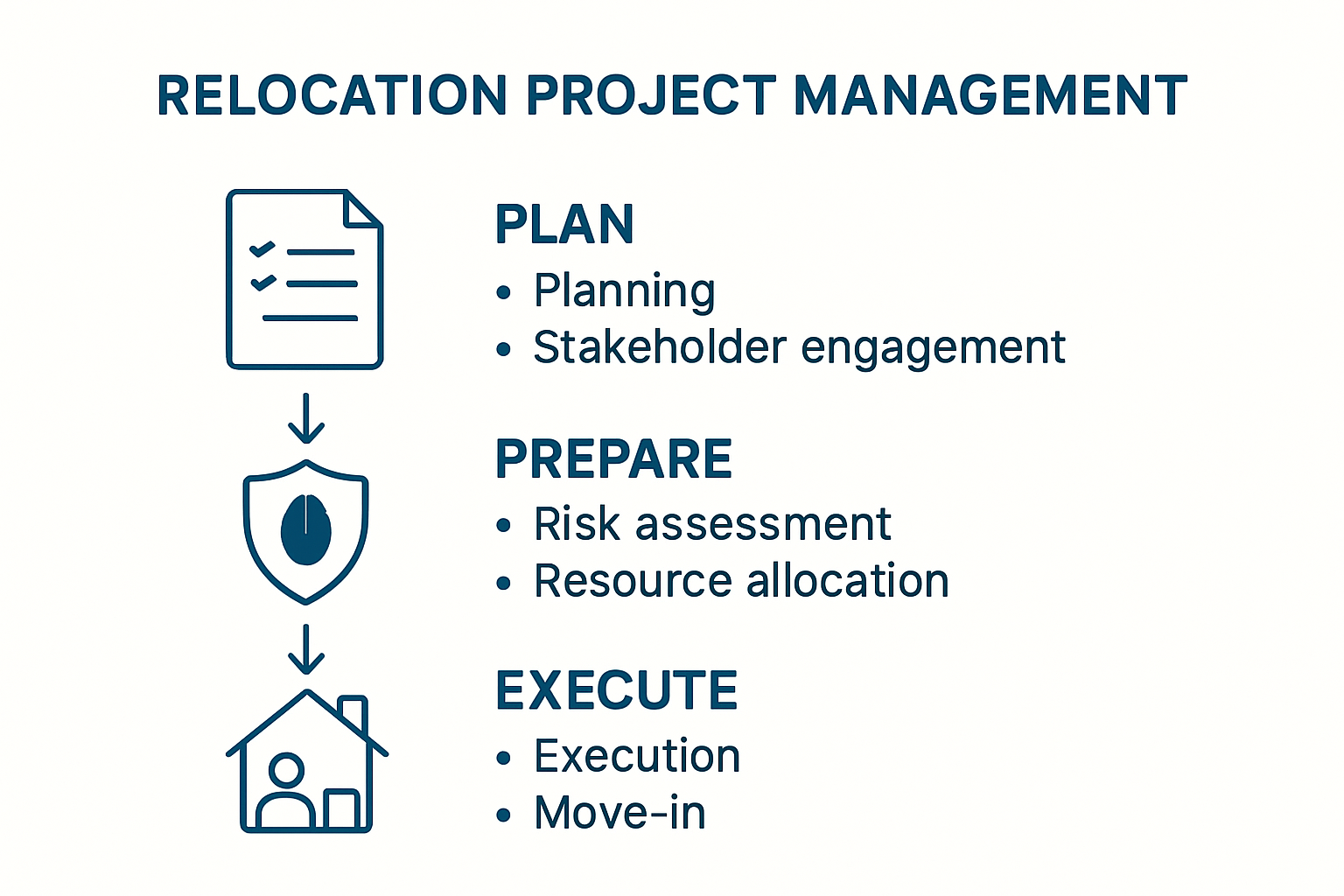
Relocation project management sounds straightforward but it actually covers a staggering amount of moving parts. Most people are surprised to learn that successful relocations hinge on managing not just logistics but also human factors, budgeting, and risk all at once.
The twist is that skipping just one of these steps can turn a simple move into an organizational nightmare and that is why getting it right matters more than most realize.
| Takeaway | Explanation |
|---|---|
| Comprehensive logistics planning is essential. | Effective relocation requires meticulous logistics to manage transportation, timing, and resource allocation. |
| Stakeholder engagement is critical for success. | Identifying and communicating with stakeholders helps align expectations and ensures a smoother transition. |
| Risk management strategies must be proactive. | Anticipating challenges and creating mitigation plans can prevent disruptions during the relocation process. |
| Understanding human dynamics enhances transitions. | Recognizing the emotional aspects of relocation aids in reducing stress and fostering productive environments. |
| Adaptability is key amidst challenges. | Developing flexible approaches allows project managers to tackle unforeseen obstacles and maintain progress. |
Relocation project management represents a comprehensive strategic approach to planning, executing, and controlling the complex process of moving individuals, teams, or entire organizations from one location to another. This specialized discipline goes far beyond simply transporting items from point A to point B. **Relocation project management encompasses comprehensive coordination of logistics, resources, timelines, and human factors to ensure a smooth, efficient transition.
Below is a table summarizing the core components of relocation project management as discussed in the article. This provides a quick reference for understanding the major domains that must be managed for a successful relocation.
| Component | Description |
|---|---|
| Comprehensive logistics planning | Organizing transportation, timing, and physical movement of people and assets |
| Resource allocation and budgeting | Assigning resources and developing a budget to ensure efficiency and cost-control |
| Risk assessment and mitigation | Identifying potential risks early and developing strategies to reduce their impact |
| Stakeholder communication and engagement | Keeping all involved parties informed and addressing their concerns |
| Timeline development and tracking | Setting project schedules and monitoring progress to ensure deadlines are met |
**
At its essence, relocation project management involves meticulous planning and systematic execution across multiple interconnected domains. According to the Society for Human Resource Management, successful relocation projects typically require strategic consideration of several critical elements:
Professional relocation project management transforms what could be a chaotic and stressful process into a structured, predictable operation. Whether managing corporate office relocations, residential moves, or specialized institutional transfers, this approach minimizes disruption and maximizes efficiency. Our comprehensive guide on office relocations provides deeper insights into navigating complex move scenarios.
The value of professional relocation project management extends beyond mere physical movement. It involves understanding the human and organizational dynamics of transition, anticipating potential challenges, and developing proactive solutions. Effective project managers must balance technical logistics with emotional intelligence, recognizing that every relocation represents a significant life or organizational change.
Ultimately, relocation project management is about creating a seamless, strategic transition that preserves productivity, minimizes stress, and sets the stage for successful adaptation in a new environment. By applying rigorous planning, sophisticated coordination, and empathetic execution, professionals can transform what might otherwise be a complicated endeavor into a smooth, manageable process.
Relocation project management operates through a complex framework of interconnected strategies and methodologies designed to facilitate seamless organizational and individual transitions. **Understanding these foundational concepts is crucial for developing a robust and effective relocation approach.

**
At the core of relocation project management lies comprehensive scope definition. According to the Project Management Institute, successful projects require meticulous initial planning that addresses multiple critical dimensions:
Risk management represents a pivotal component in relocation project management. Professionals must anticipate potential disruptions and develop proactive strategies to minimize operational impact. Explore our detailed office relocation strategies for comprehensive insights into navigating complex transition scenarios.
Effective risk management involves continuous assessment of potential challenges across multiple domains, including technological infrastructure, human resources, financial implications, and operational continuity. Successful project managers develop adaptive strategies that can quickly respond to unexpected complications while maintaining project momentum.
Ultimately, relocation project management transcends mere logistical coordination. It represents a sophisticated approach to organizational transformation that balances technical precision with strategic foresight, ensuring that transitions are not just completed, but completed with maximum efficiency and minimal disruption.
Stakeholders are the critical human infrastructure that determines the success or failure of any relocation project. They represent a complex network of individuals and groups whose interests, expectations, and actions directly influence the project’s trajectory and outcomes.
Stakeholders in relocation projects encompass a diverse range of participants, each with unique perspectives and requirements. According to the U.S. Government Accountability Office, successful project management hinges on comprehensive stakeholder identification and strategic engagement:
The following table categorizes and defines the key stakeholders in relocation projects, helping clarify the roles and interests that project managers must consider.
| Stakeholder Category | Description |
|---|---|
| Primary stakeholders | Direct beneficiaries of the relocation (e.g., employees, teams) |
| Secondary stakeholders | Indirect participants affected by the move |
| Institutional stakeholders | Organizational leadership and management |
| External stakeholders | Regulatory bodies and community representatives |
| Individual stakeholders | Employees and team members impacted on a personal level |
Effective stakeholder management transcends mere communication. It requires developing nuanced strategies that balance diverse interests while maintaining project momentum. Our comprehensive office relocation planning resource provides deeper insights into navigating complex stakeholder dynamics.
Stakeholder engagement is fundamentally about creating a shared understanding of project goals, potential challenges, and expected outcomes. Successful project managers must develop robust communication protocols that facilitate transparent, consistent dialogue, ensuring every stakeholder feels heard, valued, and integrated into the project’s strategic vision.
Ultimately, stakeholder management in relocation projects is an intricate dance of interpersonal skills, strategic communication, and empathetic leadership. By recognizing and addressing the unique needs of each stakeholder group, project managers can transform potential resistance into collaborative momentum, turning complex transitions into opportunities for organizational growth and individual development.
Relocation project management involves navigating a complex landscape of potential obstacles that can derail even the most meticulously planned transitions. Understanding these challenges and developing strategic solutions is crucial for ensuring successful project outcomes.
According to the EIS Council, relocation projects typically encounter multifaceted challenges that span technological, human, and organizational domains:
Below is a table outlining common challenges faced in relocation project management and corresponding strategic solutions, providing a clear overview for reference during planning.
| Challenge | Strategic Solution |
|---|---|
| Communication and coordination barriers | Implement flexible communication protocols |
| Cultural and interpersonal complexities | Foster inclusive and empathetic stakeholder engagement |
| Resource allocation and budget constraints | Develop thorough budgeting and resource tracking |
| Technological infrastructure transitions | Plan phased technology migration and user support |
| Legal and regulatory compliance issues | Ensure early legal review and compliance strategies |
Addressing these challenges requires a proactive, comprehensive approach that anticipates potential roadblocks. Our detailed office relocation planning guide offers in-depth strategies for navigating complex transition scenarios.
Successful project managers develop adaptive strategies that transform potential obstacles into opportunities for organizational growth. This involves creating flexible communication protocols, implementing robust risk management frameworks, and maintaining a holistic view of the project that balances technical requirements with human considerations.
Ultimately, overcoming challenges in relocation project management is not about eliminating obstacles, but about developing the organizational resilience and strategic flexibility to navigate them effectively. By anticipating potential issues, developing comprehensive mitigation strategies, and maintaining open, transparent communication, project managers can turn complex transitions into opportunities for innovation and organizational transformation.
Relocation project management transforms theoretical frameworks into practical, executable strategies across diverse organizational contexts. These real-world applications demonstrate the critical role of systematic planning and strategic execution in successful transitions.
In corporate environments, relocation project management goes beyond physical movement, involving comprehensive organizational transformation. According to the Virginia Department of Transportation, successful relocations require strategic incentive programs and precise execution:
Infrastructure projects frequently demand intricate relocation management techniques that balance technical complexity with human considerations. Our comprehensive office relocation planning resource provides deeper insights into navigating complex transition scenarios.
Professional project managers must develop adaptive approaches that integrate technological requirements, regulatory compliance, and stakeholder expectations. This involves creating flexible communication protocols, implementing robust risk management frameworks, and maintaining a holistic perspective that anticipates potential challenges before they emerge.
Ultimately, real-world relocation project management represents a sophisticated blend of strategic planning, technological expertise, and human-centered problem solving. By transforming potential obstacles into opportunities for organizational growth, project managers demonstrate the profound impact of systematic, thoughtful transition management across various complex environments.

Struggling with the uncertainty and stress highlighted in our comprehensive guide on relocation project management? From unexpected logistical challenges to managing stakeholder expectations and minimizing disruption, the journey can feel overwhelming. At US Pro Logistics, we turn those challenges into seamlessly managed solutions. Our expertise covers the exact needs described in the article, including meticulous planning, risk mitigation, and transparent communication throughout every step of your move. Whether you are relocating your office, government operations, or planning a long-distance move, our team understands the unique pressures you face and delivers efficient outcomes tailored to your goals.

Let US Pro Logistics handle the complexities so you can focus on what matters most. Ready to experience a stress-free transition and proven project management? Visit our main site to learn more about our comprehensive services. If you are seeking more insights or solutions for complicated moves, explore everything we offer under our services category. Act now to take the first step toward a smoother move—request your personalized quote today and discover the difference professional relocation project management can make.
Relocation project management is a strategic approach to planning, executing, and controlling the process of moving individuals, teams, or organizations from one location to another, encompassing logistics, resources, timelines, and human factors.
Professional relocation management minimizes disruption and maximizes efficiency during transitions, understanding the human and organizational dynamics involved and ensuring a smooth move with minimal stress.
Key components include comprehensive logistics planning, resource allocation, risk assessment, stakeholder communication, and timeline development, all of which contribute to effective project execution.
Organizations can manage risks by anticipating potential challenges, developing proactive strategies, implementing robust risk management frameworks, and maintaining open communication to ensure project continuity.
USDOT 3664256 This number is required for any company that operates commercial vehicles in interstate commerce (across state lines). It helps identify and track the safety performance and compliance of transportation companies.
MC 1268070 This number is specifically for companies involved in the transportation of goods or passengers for hire across state lines. It’s necessary for carriers operating in the moving industry and ensures they are authorized to operate as interstate carriers.